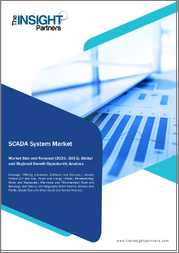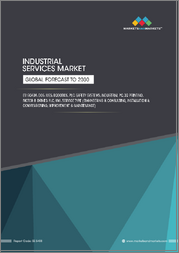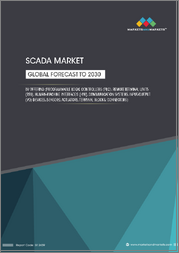
|
시장보고서
상품코드
1755957
전력 SCADA 시장 예측(-2032년) : 컴포넌트별, 아키텍처별, 시스템 유형별, 용도별, 최종사용자별, 지역별 세계 분석Power Scada Market Forecasts to 2032 - Global Analysis By Component, Architecture, System Type, Application, End User and By Geography |
||||||
Stratistics MRC에 따르면 세계의 전력 SCADA 시장은 2025년에 22억 달러를 차지하며 예측 기간 중 CAGR은 7.5%로 성장하며, 2032년에는 36억 달러에 달할 전망입니다.
전력 SCADA(Supervisory Control and Data Acquisition)는 전력 네트워크를 모니터링하고 제어하기 위한 시스템입니다. SCADA 시스템은 발전소, 변전소, 송전망의 센서 및 장비로부터 실시간 데이터를 수집하여 사업자가 배전을 관리하고, 장애를 감지하고, 성능을 최적화할 수 있도록 도와주며, SCADA 시스템은 원격 모니터링, 데이터 시각화, 자동 제어를 위한 하드웨어와 소프트웨어를 통합하여 복잡한 네트워크 전체에 안정적이고 효율적인 전력 공급을 보장합니다. 복잡한 네트워크 전체에 걸쳐 안정적이고 효율적인 전력 공급을 보장합니다.
태양에너지산업협회에 따르면 SCADA 기술은 필수 불가결한 기술입니다. 재생에너지 자산의 실시간 성능 모니터링을 가능하게 하고 기존 전력 인프라에 대한 원활한 통합을 촉진합니다.
전력 사업에서의 자동화 증가
전력 부문의 자동화로의 전환은 실시간 모니터링 및 제어를 위한 SCADA 시스템의 채택을 촉진하고 있습니다. 이러한 시스템은 배전을 최적화하고 정전을 줄임으로써 운영 효율성을 높이고 있습니다. 증가하는 에너지 수요는 송전망의 신뢰성을 보장하기 위해 첨단 모니터링이 필요합니다. 재생에너지의 통합에는 원활한 관리를 위한 첨단 SCADA 솔루션이 필요합니다. 전력 인프라 현대화에 대한 규제 의무화는 수요를 더욱 증가시킬 것입니다. 자동화 추세에 힘입어 전력 SCADA 시장은 크게 성장하고 있습니다.
높은 도입 비용
SCADA 시스템 도입에는 하드웨어, 소프트웨어, 기존 인프라와의 통합에 많은 비용이 소요됩니다. 지속적인 유지보수 및 업그레이드는 경제적 부담을 가중시킵니다. 예산이 한정된 소규모 유틸리티 기업은 이러한 시스템을 도입하는 데 어려움을 겪는 경우가 많습니다. 운영자를 위한 전문 교육이 필요하므로 전체 비용이 증가합니다. 레거시 시스템과의 복잡한 통합은 비용을 더욱 증가시킵니다. 높은 비용으로 인해 자원이 부족한 지역에서는 시장 도입에 어려움을 겪을 수 있습니다.
스마트 그리드 기술의 발전
스마트 그리드 기술의 발전은 SCADA 시스템이 그리드의 지능과 효율성을 향상시킬 수 있는 기회를 제공합니다. 이러한 시스템은 최적화된 전력 관리를 위한 실시간 데이터 분석 및 예측 유지보수를 가능하게 하며, SCADA 시스템과 IoT 및 AI의 통합은 그리드의 복원력을 향상시키고 있습니다. 재생에너지와 마이크로그리드에 대한 투자 증가는 첨단 SCADA 솔루션에 대한 수요를 촉진할 것입니다. 지속가능한 에너지 시스템에 대한 관심이 시장 기회를 촉진합니다. 스마트 그리드 기술 혁신에 힘입어 SCADA 시스템은 큰 성장을 이룰 것입니다.
데이터 프라이버시에 대한 우려
SCADA 시스템이 클라우드 기반 플랫폼로 연결되면 데이터 유출 및 사이버 공격의 위험이 높아집니다. 중요한 전력 인프라에 대한 무단 액세스는 운영을 중단시키고 안전을 해칠 수 있습니다. 표준화된 사이버 보안 프로토콜이 없기 때문에 취약성이 증가합니다. 데이터 보호법 규정 준수로 인해 시스템 구축이 복잡해집니다. 프라이버시에 대한 우려로 인해 일부 전력회사들이 커넥티드 SCADA 솔루션 도입을 주저하고 있습니다. 사이버 리스크의 영향을 받아 시장은 데이터 보안 확보라는 과제에 직면해 있습니다.
COVID-19의 영향
COVID-19 팬데믹은 공급망 지연과 설비 투자 감소로 인해 SCADA 시스템 구축에 혼란을 초래했습니다. 그러나 봉쇄 기간 중 원격 모니터링의 필요성은 클라우드 기반 SCADA 솔루션의 채택을 가속화했습니다. 팬데믹은 중요한 서비스를 지원하는 탄력적인 전력 인프라의 중요성을 강조했습니다. 예산의 제약으로 인해 위기 기간 중 일부 전력 회사들은 업그레이드를 제한했습니다. 팬데믹 이후 자동화와 원격 제어에 대한 집중은 시장 회복을 촉진했습니다. 신뢰성의 필요성에 따라 SCADA 시장은 다시 견인력을 회복하고 있습니다.
마스터 터미널 유닛(MTU) 부문이 예측 기간 중 가장 큰 시장으로 부상할 것으로 예측됩니다.
마스터 터미널 유닛(MTU) 부문은 중앙 집중식 모니터링 제어에서 중요한 역할을 수행하여 예측 기간 중 가장 큰 시장 점유율을 차지할 것으로 예측됩니다. 마스터 터미널 유닛은 효율적인 그리드 관리를 위해 원격 터미널 유닛에서 실시간 데이터 통합을 가능하게 합니다. 전력망의 복잡성이 증가함에 따라 강력한 MTU에 대한 수요가 증가하고 있습니다. 고급 분석 기능과의 통합을 통해 운영상의 의사결정을 강화할 수 있습니다. 그리드 현대화에 대한 투자 증가는 MTU의 채택을 더욱 촉진하고 있습니다. 중앙 집중식 제어의 필요성으로 인해 MTU 부문이 가장 큰 시장 점유율을 차지하고 있습니다.
예측 기간 중 하드웨어 부문이 가장 높은 CAGR을 나타낼 것으로 예측됩니다.
예측 기간 중 SCADA 시스템에서 첨단 센서 및 통신 장비의 도입이 증가함에 따라 하드웨어 부문이 가장 높은 성장률을 나타낼 것으로 예상되며, IoT 지원 장비와 같은 하드웨어 혁신은 시스템의 성능과 신뢰성을 향상시키고 있습니다. 재생에너지원의 통합은 업그레이드된 하드웨어 구성 요소에 대한 수요를 촉진할 것입니다. 실시간 데이터 수집에 대한 관심은 하드웨어의 발전을 촉진합니다. 지속적인 기술 개발이 시장 확대를 지원합니다. 하드웨어의 기술 혁신에 힘입어 이 부문은 가장 높은 성장률을 보일 것입니다.
가장 큰 점유율을 차지하는 지역
예측 기간 중 아시아태평양은 급속한 도시화와 에너지 수요 증가로 인해 가장 큰 시장 점유율을 차지할 것으로 예측됩니다. 중국과 인도와 같은 국가들은 전력망 현대화 및 재생에너지 프로젝트에 많은 투자를 하고 있습니다. 이 지역은 스마트 그리드 기술에 중점을 두고 있으며, SCADA의 채택을 촉진하고 있습니다. 지속가능한 에너지 인프라에 대한 정부의 구상이 시장 성장을 지원하고 있습니다. 업그레이드가 필요한 노후화된 전력망의 존재는 수요를 더욱 증가시킬 것입니다. 견고한 에너지 수요에 힘입어 아시아태평양은 세계 SCADA 시장을 주도하고 있습니다.
CAGR이 가장 높은 지역
예측 기간 중 북미는 첨단 기술 인프라와 규제 지원으로 인해 가장 높은 CAGR을 보일 것으로 예측됩니다. 이 지역은 스마트 그리드와 재생에너지의 통합에 중점을 두어 SCADA의 채택을 촉진하고 있습니다. 연구개발에 대한 막대한 투자는 시스템의 기능과 성능을 향상시킬 것입니다. 대형 유틸리티 사업자의 존재는 시장 확대를 촉진합니다. 그리드 신뢰성과 사이버 보안에 대한 중요성이 시장 성장을 강화합니다. 기술 혁신에 힘입어 북미는 급속한 시장 확대가 예상됩니다.
무료 커스터마이징 서비스
이 보고서를 구독하는 고객은 다음과 같은 무료 맞춤화 옵션 중 하나를 이용할 수 있습니다.
- 기업소개
- 추가 시장 진출기업의 종합적인 프로파일링(최대 3사)
- 주요 기업의 SWOT 분석(최대 3사)
- 지역 세분화
- 고객의 관심에 따른 주요 국가별 시장 추정 및 예측, CAGR(주: 타당성 확인에 따라 다름)
- 경쟁사 벤치마킹
- 제품 포트폴리오, 지역적 입지, 전략적 제휴를 통한 주요 기업 벤치마킹
목차
제1장 개요
제2장 서문
- 개요
- 이해관계자
- 조사 범위
- 조사 방법
- 데이터 마이닝
- 데이터 분석
- 데이터 검증
- 조사 어프로치
- 조사 자료
- 1차 조사 자료
- 2차 조사 자료
- 전제조건
제3장 시장 동향 분석
- 서론
- 촉진요인
- 억제요인
- 기회
- 위협
- 용도 분석
- 신흥 시장
- COVID-19의 영향
제4장 Porter's Five Forces 분석
- 공급 기업의 교섭력
- 바이어의 교섭력
- 대체품의 위협
- 신규 진출업체의 위협
- 경쟁 기업 간 경쟁 관계
제5장 세계의 전력 SCADA 시장 : 컴포넌트별
- 서론
- 마스터 단말기 유닛(MTU)
- 리모트 터미널 유닛(RTU)
- 휴먼 머신 인터페이스(HMI)
- 프로그래머블 로직 컨트롤러(PLC)
- 통신 시스템
- 보호 계전기(IED)
- 기타
제6장 세계의 전력 SCADA 시장 : 아키텍처별
- 서론
- 하드웨어
- 서비스
- 소프트웨어
제7장 세계의 전력 SCADA 시장 : 시스템 유형별
- 서론
- 기존형 SCADA
- 스마트 SCADA
제8장 세계의 전력 SCADA 시장 : 용도별
- 서론
- 배전
- 공급 자동화
- 전압 무효 전력 관리
- 발전
- 수력발전
- 원자력
- 송전
- 기타
제9장 세계의 전력 SCADA 시장 : 최종사용자별
- 서론
- 산업 제조업
- 전력회사
- 석유 및 가스
- 통신
- 자동차·운송
- 기타
제10장 세계의 전력 SCADA 시장 : 지역별
- 서론
- 북미
- 미국
- 캐나다
- 멕시코
- 유럽
- 독일
- 영국
- 이탈리아
- 프랑스
- 스페인
- 기타 유럽
- 아시아태평양
- 일본
- 중국
- 인도
- 호주
- 뉴질랜드
- 한국
- 기타 아시아태평양
- 남미
- 아르헨티나
- 브라질
- 칠레
- 기타 남미
- 중동 및 아프리카
- 사우디아라비아
- 아랍에미리트
- 카타르
- 남아프리카공화국
- 기타 중동 및 아프리카
제11장 주요 개발
- 계약, 파트너십, 협업, 조인트 벤처
- 인수와 합병
- 신제품 발매
- 사업 확대
- 기타 주요 전략
제12장 기업 프로파일링
- Eaton Corporation
- ABB Ltd.
- Emerson Electric Co.
- General Electric Company
- Hitachi
- Honeywell International Inc.
- Inductive Automation
- Mitsubishi Electric Corporation
- Omron Corporation
- PSI AG
- Rockwell Automation, Inc.
- Schneider Electric SE
- Siemens AG
- Toshiba
- Yokogawa Electric Corporation
According to Stratistics MRC, the Global Power Scada Market is accounted for $2.2 billion in 2025 and is expected to reach $3.6 billion by 2032 growing at a CAGR of 7.5% during the forecast period. Power SCADA (Supervisory Control and Data Acquisition) is a system for monitoring and controlling electrical power networks. It collects real-time data from sensors and devices in power plants, substations, and grids, enabling operators to manage electricity distribution, detect faults, and optimize performance. SCADA systems integrate hardware and software for remote monitoring, data visualization, and automated control, ensuring reliable and efficient power delivery across complex networks.
According to the Solar Energy Industries Association, SCADA technology becomes essential. It enables operators to monitor the real-time performance of renewable energy assets and facilitates their seamless integration into the existing power infrastructure.
Market Dynamics:
Driver:
Rising automation in power utilities
The power sector's shift toward automation is driving the adoption of SCADA systems for real-time monitoring and control. These systems enhance operational efficiency by optimizing power distribution and reducing outages. Growing energy demands necessitate advanced monitoring to ensure grid reliability. The integration of renewable energy sources requires sophisticated SCADA solutions for seamless management. Regulatory mandates for modernized power infrastructure further boost demand. Fueled by automation trends, the power SCADA market is experiencing significant growth.
Restraint:
High implementation costs
Implementing SCADA systems involves substantial costs for hardware, software, and integration with existing infrastructure. Ongoing maintenance and upgrades add to the financial burden. Small utilities with limited budgets often struggle to adopt these systems. The need for specialized training for operators increases overall expenses. Complex integration with legacy systems can further escalate costs. Triggered by high costs, market adoption faces challenges in resource-constrained regions.
Opportunity:
Smart grid technology advancements
Advancements in smart grid technologies create opportunities for SCADA systems to enhance grid intelligence and efficiency. These systems enable real-time data analytics and predictive maintenance for optimized power management. The integration of IoT and AI with SCADA systems improves grid resilience. Growing investments in renewable energy and microgrids drive demand for advanced SCADA solutions. The focus on sustainable energy systems fuels market opportunities. Spurred by smart grid innovations, SCADA systems are poised for significant growth.
Threat:
Data privacy concerns
The connectivity of SCADA systems to cloud-based platforms increases the risk of data breaches and cyberattacks. Unauthorized access to critical power infrastructure could disrupt operations and compromise safety. The lack of standardized cybersecurity protocols heightens vulnerabilities. Regulatory compliance with data protection laws adds complexity to system deployment. Privacy concerns deter some utilities from adopting connected SCADA solutions. Influenced by cyber risks, the market faces challenges in ensuring data security.
Covid-19 Impact:
The COVID-19 pandemic disrupted SCADA system deployments due to supply chain delays and reduced capital investments. However, the need for remote monitoring during lockdowns accelerated the adoption of cloud-based SCADA solutions. The pandemic highlighted the importance of resilient power infrastructure to support critical services. Budget constraints limited upgrades for some utilities during the crisis. The focus on automation and remote operations post-pandemic has boosted market recovery. Guided by the need for reliability, the SCADA market is regaining traction.
The master terminal unit (MTU) segment is expected to be the largest during the forecast period
The master terminal unit (MTU) segment is expected to account for the largest market share during the forecast period, due to their critical role in centralized monitoring and control. They enable real-time data aggregation from remote terminal units for efficient grid management. The growing complexity of power networks drives demand for robust MTUs. Their integration with advanced analytics enhances operational decision-making. Rising investments in grid modernization further support their adoption. Powered by the need for centralized control, the MTU segment holds the largest market share.
The hardware segment is expected to have the highest CAGR during the forecast period
Over the forecast period, the hardware segment is predicted to witness the highest growth rate, due to the increasing deployment of advanced sensors and communication devices in SCADA systems. Innovations in hardware, such as IoT-enabled devices, enhance system performance and reliability. The integration of renewable energy sources drives demand for upgraded hardware components. The focus on real-time data collection fuels hardware advancements. Ongoing technological developments support market expansion. Propelled by hardware innovations, this segment is set for the highest growth rate.
Region with largest share:
During the forecast period, the Asia Pacific region is expected to hold the largest market share, due to its rapid urbanization and growing energy demands. Countries like China and India are investing heavily in grid modernization and renewable energy projects. The region's focus on smart grid technologies drives SCADA adoption. Government initiatives for sustainable energy infrastructure support market growth. The presence of aging power networks requiring upgrades further boosts demand. Backed by robust energy demands, Asia Pacific leads the global SCADA market.
Region with highest CAGR:
Over the forecast period, the North America region is anticipated to exhibit the highest CAGR, due to its advanced technological infrastructure and regulatory support. The region's focus on smart grids and renewable energy integration fuels SCADA adoption. Significant investments in R&D enhance system capabilities and performance. The presence of major utility providers drives market expansion. The emphasis on grid reliability and cybersecurity strengthens the market's growth. Motivated by innovation, North America is poised for rapid market expansion.
Key players in the market
Some of the key players in Power Scada Market include Eaton Corporation, ABB Ltd., Emerson Electric Co., General Electric Company, Hitachi, Honeywell International Inc., Inductive Automation, Mitsubishi Electric Corporation, Omron Corporation, PSI AG, Rockwell Automation, Inc., Schneider Electric SE, Siemens AG, Toshiba, and Yokogawa Electric Corporation
Key Developments:
In May 2025, ABB integrated its OmniCore(TM) automation platform with SCADA systems for power utilities. The solution enhances real-time grid monitoring with AI-driven analytics, improving reliability and efficiency in smart grid applications.
In April 2025, Schneider Electric upgraded its EcoStruxure SCADA platform with advanced cybersecurity features. The system supports predictive maintenance and seamless integration with renewable energy sources, addressing the growing demand for secure, automated power management.
In March 2025, Siemens enhanced its MindSphere SCADA platform with IoT connectivity for real-time data analytics. The upgrade optimizes power distribution and supports smart grid scalability, targeting utilities in North America and Asia Pacific.
In February 2025, Honeywell launched an updated Experion SCADA system with cloud-based monitoring for power utilities. It offers enhanced data visualization and predictive analytics, improving grid resilience and operational efficiency in renewable energy integration.
Components Covered:
- Master Terminal Unit (MTU)
- Remote Terminal Unit (RTU)
- Human Machine Interface (HMI)
- Programmable Logic Controller (PLC)
- Communication Systems
- Protection Relay (IED's)
- Other Components
Architectures Covered:
- Hardware
- Services
- Software
Service Types Covered:
- Sensors
- Probes and Analyzers
- Software and Services
System Types Covered:
- Traditional SCADA
- Smart SCADA
Applications Covered:
- Distribution
- Generation
- Transmission
- Other Applications
End Users Covered:
- Industrial Manufacturing
- Electric Utilities
- Oil & Gas
- Telecommunication
- Automotive & Transportation
- Other End Users
Regions Covered:
- North America
- US
- Canada
- Mexico
- Europe
- Germany
- UK
- Italy
- France
- Spain
- Rest of Europe
- Asia Pacific
- Japan
- China
- India
- Australia
- New Zealand
- South Korea
- Rest of Asia Pacific
- South America
- Argentina
- Brazil
- Chile
- Rest of South America
- Middle East & Africa
- Saudi Arabia
- UAE
- Qatar
- South Africa
- Rest of Middle East & Africa
What our report offers:
- Market share assessments for the regional and country-level segments
- Strategic recommendations for the new entrants
- Covers Market data for the years 2024, 2025, 2026, 2028, and 2032
- Market Trends (Drivers, Constraints, Opportunities, Threats, Challenges, Investment Opportunities, and recommendations)
- Strategic recommendations in key business segments based on the market estimations
- Competitive landscaping mapping the key common trends
- Company profiling with detailed strategies, financials, and recent developments
- Supply chain trends mapping the latest technological advancements
Free Customization Offerings:
All the customers of this report will be entitled to receive one of the following free customization options:
- Company Profiling
- Comprehensive profiling of additional market players (up to 3)
- SWOT Analysis of key players (up to 3)
- Regional Segmentation
- Market estimations, Forecasts and CAGR of any prominent country as per the client's interest (Note: Depends on feasibility check)
- Competitive Benchmarking
- Benchmarking of key players based on product portfolio, geographical presence, and strategic alliances
Table of Contents
1 Executive Summary
2 Preface
- 2.1 Abstract
- 2.2 Stake Holders
- 2.3 Research Scope
- 2.4 Research Methodology
- 2.4.1 Data Mining
- 2.4.2 Data Analysis
- 2.4.3 Data Validation
- 2.4.4 Research Approach
- 2.5 Research Sources
- 2.5.1 Primary Research Sources
- 2.5.2 Secondary Research Sources
- 2.5.3 Assumptions
3 Market Trend Analysis
- 3.1 Introduction
- 3.2 Drivers
- 3.3 Restraints
- 3.4 Opportunities
- 3.5 Threats
- 3.6 Application Analysis
- 3.7 Emerging Markets
- 3.8 Impact of Covid-19
4 Porters Five Force Analysis
- 4.1 Bargaining power of suppliers
- 4.2 Bargaining power of buyers
- 4.3 Threat of substitutes
- 4.4 Threat of new entrants
- 4.5 Competitive rivalry
5 Global Power Scada Market, By Component
- 5.1 Introduction
- 5.2 Master Terminal Unit (MTU)
- 5.3 Remote Terminal Unit (RTU)
- 5.4 Human Machine Interface (HMI)
- 5.5 Programmable Logic Controller (PLC)
- 5.6 Communication Systems
- 5.7 Protection Relay (IED's)
- 5.8 Other Components
6 Global Power Scada Market, By Architecture
- 6.1 Introduction
- 6.2 Hardware
- 6.3 Services
- 6.4 Software
7 Global Power Scada Market, By System Type
- 7.1 Introduction
- 7.2 Traditional SCADA
- 7.3 Smart SCADA
8 Global Power Scada Market, By Application
- 8.1 Introduction
- 8.2 Distribution
- 8.2.1 Feeder Automation
- 8.2.2 Volt Var Management
- 8.3 Generation
- 8.3.1 Hydro
- 8.3.2 Nuclear
- 8.4 Transmission
- 8.5 Other Applications
9 Global Power Scada Market, By End User
- 9.1 Introduction
- 9.2 Industrial Manufacturing
- 9.3 Electric Utilities
- 9.4 Oil & Gas
- 9.5 Telecommunication
- 9.6 Automotive & Transportation
- 9.7 Other End Users
10 Global Power Scada Market, By Geography
- 10.1 Introduction
- 10.2 North America
- 10.2.1 US
- 10.2.2 Canada
- 10.2.3 Mexico
- 10.3 Europe
- 10.3.1 Germany
- 10.3.2 UK
- 10.3.3 Italy
- 10.3.4 France
- 10.3.5 Spain
- 10.3.6 Rest of Europe
- 10.4 Asia Pacific
- 10.4.1 Japan
- 10.4.2 China
- 10.4.3 India
- 10.4.4 Australia
- 10.4.5 New Zealand
- 10.4.6 South Korea
- 10.4.7 Rest of Asia Pacific
- 10.5 South America
- 10.5.1 Argentina
- 10.5.2 Brazil
- 10.5.3 Chile
- 10.5.4 Rest of South America
- 10.6 Middle East & Africa
- 10.6.1 Saudi Arabia
- 10.6.2 UAE
- 10.6.3 Qatar
- 10.6.4 South Africa
- 10.6.5 Rest of Middle East & Africa
11 Key Developments
- 11.1 Agreements, Partnerships, Collaborations and Joint Ventures
- 11.2 Acquisitions & Mergers
- 11.3 New Product Launch
- 11.4 Expansions
- 11.5 Other Key Strategies
12 Company Profiling
- 12.1 Eaton Corporation
- 12.2 ABB Ltd.
- 12.3 Emerson Electric Co.
- 12.4 General Electric Company
- 12.5 Hitachi
- 12.6 Honeywell International Inc.
- 12.7 Inductive Automation
- 12.8 Mitsubishi Electric Corporation
- 12.9 Omron Corporation
- 12.10 PSI AG
- 12.11 Rockwell Automation, Inc.
- 12.12 Schneider Electric SE
- 12.13 Siemens AG
- 12.14 Toshiba
- 12.15 Yokogawa Electric Corporation



















